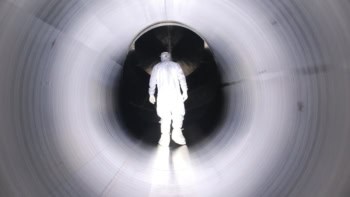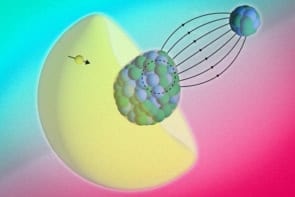Physicists at Indiana University have observed a rare reaction that violates charge symmetry for the first time. Edward Stephenson and co-workers made the breakthrough by detecting pions and helium nuclei that were produced in collisions between heavy isotopes of hydrogen. The discovery, which was announced at a meeting of the American Physical Society earlier this week, should help physicists understand why more protons than neutrons were left over after the big bang.
According to charge symmetry protons and neutrons should have the same properties. This symmetry is obviously broken because the proton has a positive electric charge while the neutron is neutral. Moreover, the neutron is slightly heavier than the proton and decays into a proton, an electron and a neutrino after about ten minutes. However, protons and neutrons behave the same in many other nuclear reactions.
Stephenson and co-workers used the cyclotron facility at Indiana to direct a beam of deuterons – nuclei that contain one proton and one neutron – through a target of deuterium gas. All of the helium nuclei made in this process were collected and detected. The short-lived pions produced in the reaction decay into pairs of photons, which were also detected. The team collected enough events to be able to calculate the rate at which the fusion reaction occurs.
Theoretical physicists believe that charge symmetry breaking originates with quarks – the particles that make up protons and neutrons. A proton contains two “up” quarks and one “down” quark, while a neutron contains one up and two down quarks. Part of the violation is thought to result from the fact that up and down quarks have different charges – +2/3 and -1/3 respectively – and part is thought to be due to their different masses.
“The solution to this riddle is part of the story of the formation of the universe after the big bang,” Stephenson told PhysicsWeb. “As the universe cooled, a point was reached where neutrons and protons could exist separately. As a result of charge symmetry breaking, more protons than neutrons were formed and thus, the early universe contained hydrogen – which later fuelled the stars. If the proton had been heavier, then neutrons would have been the most abundant particle and hydrogen would not have survived.”
The Indiana team plan to submit its results to Physical Review Letters shortly.



